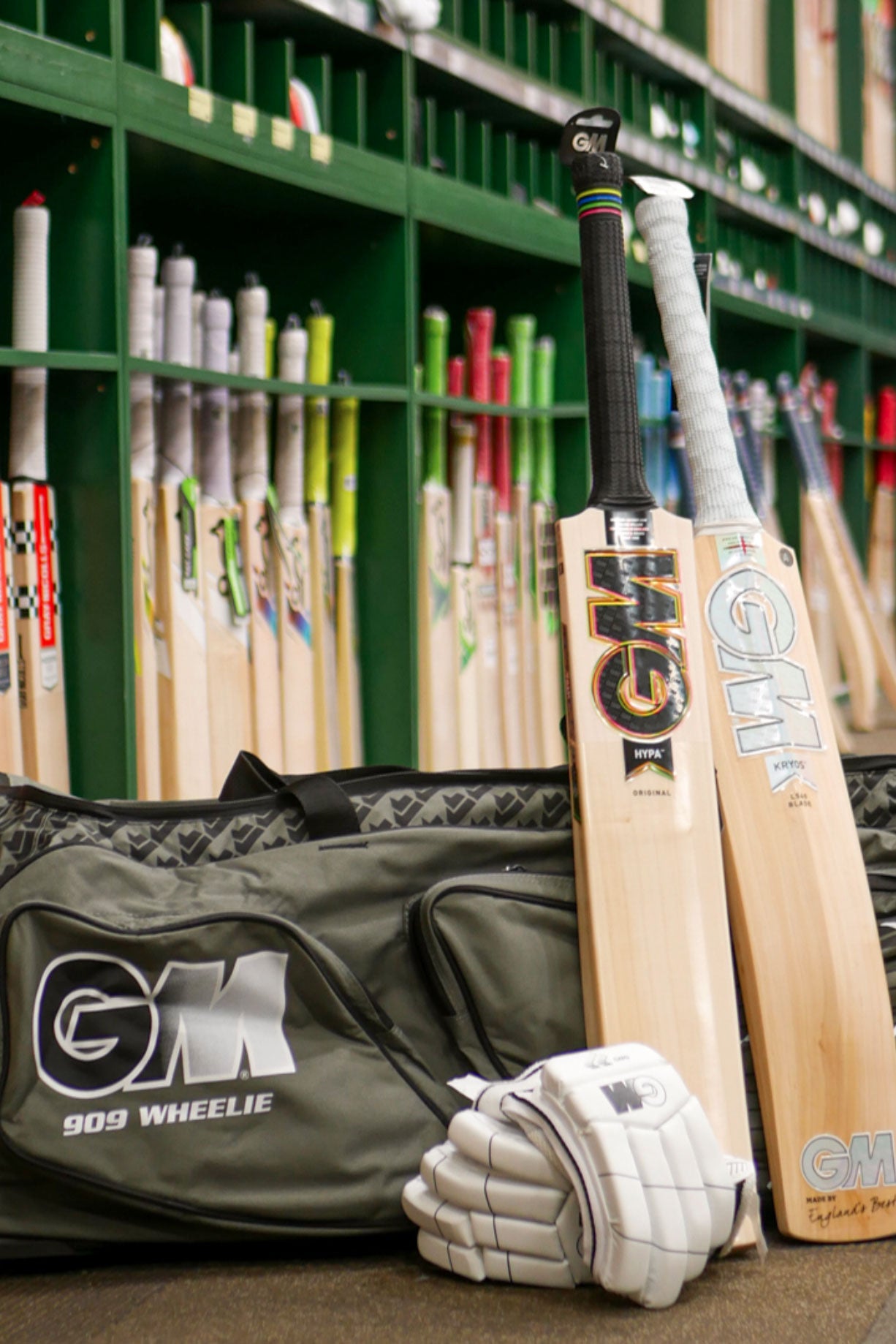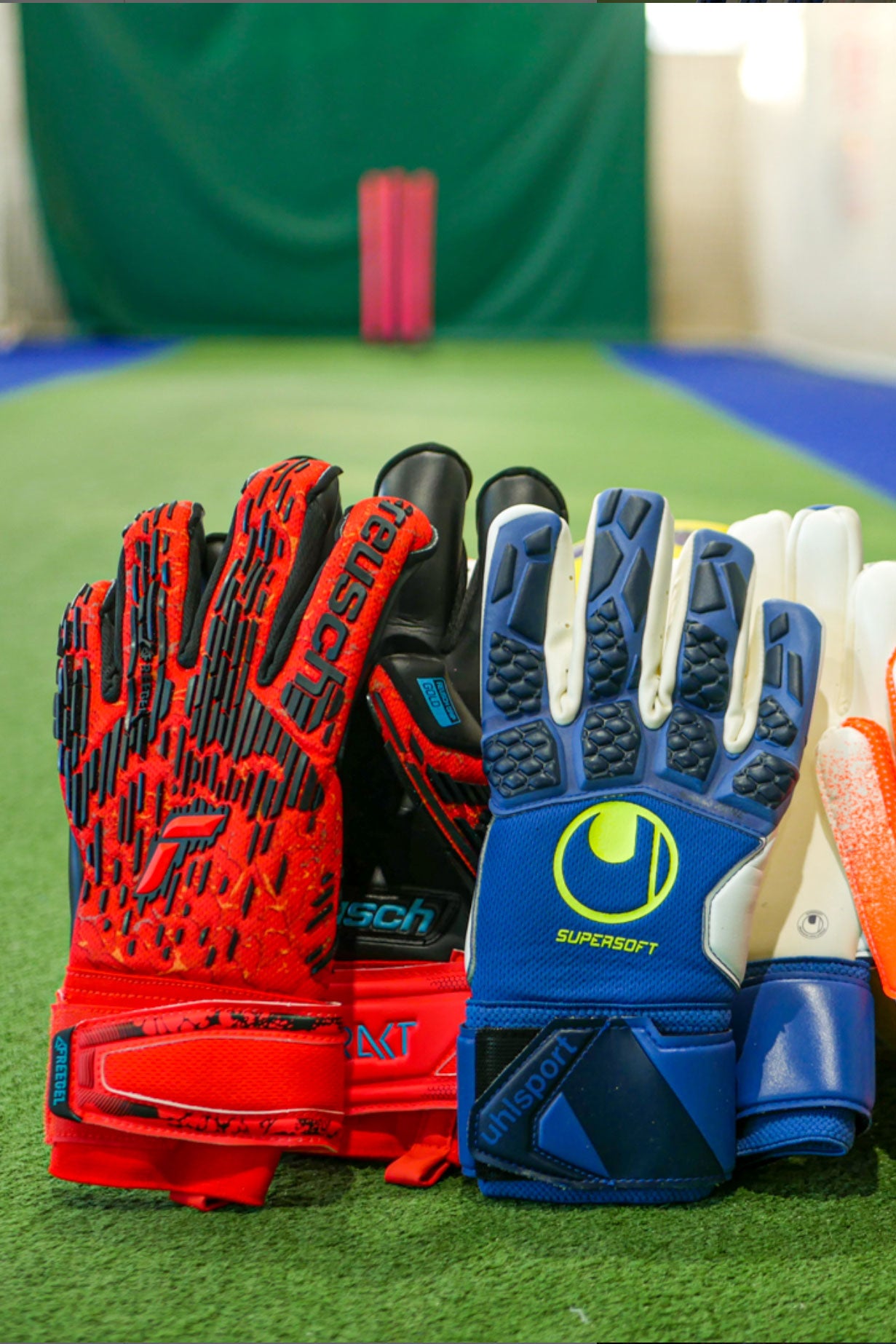Free knocking-in on all cricket bats
BUY NOW, PAY LATER WITH AFTERPAY
Free knocking-in on all cricket bats
BUY NOW, PAY LATER WITH AFTERPAY
Soccer
brands
Cricket Bat Care
November 09, 2025 11 min read
Proper cricket bat care protects the willow, improves performance, and can extend a bat’s lifespan by several seasons, especially for English willow bats. A well-maintained bat not only performs better in the middle but also withstands the wear and tear that naturally comes from regular play. From initial preparation such as knocking-in and oiling, to ongoing maintenance like cleaning and checking for cracks, each step plays a crucial role in preserving the bat’s condition. Whether you’re a casual weekend player or a serious cricketer, understanding how to care for your bat ensures that every innings is backed by consistent performance and durability.
Quick Guide: How to Take Care of a Cricket Bat
Oiling: Lightly apply raw linseed or specialist bat oil to the exposed willow (avoiding stickers and splice) to keep the wood supple and prevent cracking. Modern bats generally only need to be oiled once per season.
Knocking-In: Gradually compress the bat’s fibers using a mallet or old ball, focusing on the face and edges. Start gently and increase force over time to prepare the bat for match conditions and prevent surface damage.
Storage: Store the bat in a cool, dry place away from direct sunlight, moisture, or excessive heat. Avoid leaving it in car boots or damp gear bags, as temperature and humidity changes can cause warping or splitting.
Anti-Scuff Sheet: After oiling and knocking-in, apply a clear protective sheet or fibreglass tape to the face and edges. This adds a layer of protection against cracks and extends the bat’s finish.
Regular Inspection: Routinely check for cracks, or loose bindings. Address any minor issues early, such as sanding small cracks or replacing worn grips, to keep the bat in optimal playing condition.
Why Cricket Bat Maintenance Matters (Especially for English Willow)
High-performance cricket bats made from English willow require regular maintenance due to their softer grain and natural finish. This premium timber delivers superior performance — a lighter pickup, better balance, and exceptional “ping” off the middle — but its delicate structure means it’s more vulnerable to cracks, dryness, and moisture damage if not properly cared for.
In contrast, Kashmir willow bats are denser and more durable, making them ideal for players who want a low-maintenance option. While they don’t offer quite the same rebound or responsiveness as English willow, they can withstand rougher conditions and require less oiling and upkeep.
In short: English willow gives better ping but needs more care, whereas Kashmir willow is tougher and more forgiving but lower-performing — making your choice dependent on how much performance you want versus how much maintenance you’re willing to commit to.
English Willow – Performance Comes with Upkeep
English willow bats — used by top brands like Gray-Nicolls, Kookaburra, and Gunn & Moore — are prized for their power, balance, and responsiveness, but they also demand consistent care. Their softer, high-grade willow benefits greatly from regular care, which prevents the wood from drying out and cracking. Initially, knocking-in is essential to compress the bat’s fibers, ensuring it can handle the impact of a hard new ball without damage. Proper storage is equally important — bats should be kept in a cool, dry environment away from direct sunlight or damp conditions to preserve the timber. With the right preparation and maintenance, an English willow bat can deliver exceptional performance season after season.
Kashmir Willow – More Forgiving But Lower Sensitivity
Kashmir willow bats are naturally heavier and denser than their English willow counterparts, giving them a solid, sturdy feel at the crease. This added density means they can tolerate more neglect—such as irregular oiling or less-than-ideal storage—without showing immediate signs of damage. While they don’t offer the same level of responsiveness or “ping” as English willow, their resilience makes them a great option for casual players or those training in tougher conditions. The harder grain structure helps the bat withstand rougher surfaces, making Kashmir willow a low-maintenance, long-lasting choice for players who value durability over top-tier performance.
Step-by-Step Care Routine for a New Cricket Bat
When purchasing a new English Willow cricket bat, it’s important to prepare it properly before use. This ensures the willow is conditioned, protected, and ready to perform at its best.
-
Oiling:
-
Apply a light coat of raw linseed oil to the exposed areas of the willow (avoiding stickers and the splice).
-
Allow to dry overnight before applying the next.
-
This process nourishes the wood, keeping it supple and reducing the risk of cracking.
-
Knocking-In:
-
After oiling, use a bat mallet or old ball to gently compress the face and edges of the bat.
-
Start with light taps and gradually increase the force over several hours.
-
Pay special attention to the edges and toe but avoid striking them directly with full force early on.
-
This step readies the bat to handle the impact of real cricket balls safely.
-
Anti-Scuff Sheet or Edge Tape:
-
Once knocking-in is complete, apply a clear anti-scuff sleeve or fibreglass sleeve to protect the face of the bat. You can also reinforce the edges with fibreglass tape for added durability.
-
These layers reduce wear and tear, help prevent surface cracks, and keep the bat looking new for longer.
Following these steps ensures your new bat is match-ready, offering maximum performance and durability from the very first innings.
Oiling the Bat (Only If Natural Face)
If your bat has a natural, unfinished face, it requires light oiling to condition the willow and prevent it from drying out. Apply raw linseed oil sparingly using a soft cloth or your fingertips, focusing on the face, edges, and toe while avoiding stickers, the splice, and the handle. A light coat is usually sufficient, allowing it to dry overnight. Avoid over-oiling, as excess oil can make the bat heavy, soften the willow too much, and cause swelling or splitting. Proper oiling keeps the wood supple, enhancing its longevity and performance.
Knocking-In Process
Once oiled and fully dried, your bat needs to be knocked-in to prepare the willow for the impact of real cricket balls. Start by using a specialist bat mallet to gently strike the face and edges, gradually increasing the force over several hours. Focus on compressing the wood evenly—this process strengthens the fibers and reduces the risk of cracking.
After the initial mallet work, move on to soft-ball net sessions, using an old or softer cricket ball to simulate real play. This helps the bat adapt to match conditions and finalises the knocking-in process. Avoid using a brand-new ball too early, as it can damage an unprepared bat. Read our blog on how to knock in a cricket bat to learn more.

Anti-Scuff Sheet and Toe Guard Application
Adding protective materials to your bat’s face and toe is essential for preserving its condition and extending its lifespan. The face can be covered with a clear anti-scuff sheet or fibreglass sleeve, which guards against surface cracks, seam marks, and moisture absorption. Apply the sheet smoothly to a clean, dry surface after oiling and knocking-in, pressing out any air bubbles for a firm, even finish.
The toe—one of the most vulnerable areas—benefits from a toe guard or a layer of shoe goo. This prevents moisture damage from damp pitches and reduces the risk of splitting when the bat strikes the ground.
Together, these protective layers not only maintain the bat’s appearance but also reinforce high-impact areas, ensuring consistent performance and durability throughout the season.
Ongoing Cricket Bat Care Tips Throughout the Season
To keep your cricket bat performing at its best throughout the season, regular care after use is just as important as preparation. Follow this simple maintenance checklist to preserve the willow and prevent long-term damage:
-
Wipe Down: After each session, use a clean, dry cloth to remove dirt, grass, and moisture from the face and edges. Never leave the bat damp or dirty in a bag.
-
Check Edges and Face: Inspect for small cracks, seam marks, or dents. Early repair—such as light sanding or edge tape replacement—prevents further damage.
-
Reapply Oil (If Natural Face): Lightly reapply oil once per season or when the willow appears dry. Avoid over-oiling, which can soften and weaken the wood.
-
Grip Maintenance: Ensure the handle grip is secure and comfortable. Replace worn or loose grips to maintain control and reduce strain on the hands. Read our blog on how to put a grip on a cricket bat to learn more.
-
Storage: Always store the bat in a cool, dry environment away from direct sunlight or humidity. Avoid leaving it in car boots or near heaters.
Consistent upkeep not only extends the life of your bat but also ensures it performs at its peak every time you step onto the field.
Storage and Moisture Control
Proper storage is crucial for preserving your bat’s shape, moisture balance, and overall lifespan. Always store your bat in a cool, dry place away from direct sunlight, heat, or humidity. Avoid leaving it in a car boot, garage, or damp shed, as extreme temperatures and moisture can cause the willow to warp, swell, or crack. Ideally, keep it indoors in a room with stable conditions, and if possible, stand it upright or in a bat cover to maintain its form. Good storage habits ensure your bat stays match-ready and in top condition throughout the year.
Dealing with Small Cracks and Dents
Even with proper care, minor damage can occur over time — especially on the face, edges, or toe. Small surface cracks can often be managed with a light application of super glue to seal the split, followed by fibreglass tape or an anti-scuff sheet for added reinforcement. Light dents or rough patches can be gently sanded down to restore a smooth surface before reapplying oil if needed.
For major cracks, deep splits, or structural damage, it’s best to take the bat to a professional repairer or specialist. Attempting large repairs at home can worsen the issue or affect balance and performance. Regular inspections and prompt attention to small flaws will help keep your bat in prime condition for many seasons.
Handle and Grip Maintenance
Your bat’s handle and grip play a key role in comfort, control, and performance, so they should be checked regularly. Over time, grips can become worn, slippery, or loose, affecting your hold and shot accuracy. Replace worn grips promptly—using a bat cone or grip applicator makes the process quick and even.
Additionally, inspect the handle for any signs of looseness or separation from the blade. A soft or wobbly feel when striking the ball may indicate that the handle needs professional repair or re-binding. Addressing these issues early not only maintains your bat’s balance and feel but also prevents more serious structural damage.
Off-Season Bat Storage and Long-Term Preservation
When the season ends, your bat still needs care to stay in top condition for the next one. Store it in a cool, dry environment with stable temperatures — avoid garages, sheds, or car boots, which can expose the bat to moisture, heat, or cold that causes warping or drying out. Before storing, clean the face and edges, check for any cracks, and apply a light coat of oil if the bat has a natural finish to keep the willow nourished.
If possible, store the bat vertically (handle up) or in a bat cover or padded bag to prevent pressure marks or deformities. Keeping your bat well-protected during the off-season ensures it stays strong, and ready for action when play resumes.
Common Mistakes That Damage Your Cricket Bat
Even experienced players can shorten their bat’s lifespan by overlooking a few key care steps. Here are some of the most common mistakes to avoid:
-
Skipping the knocking-in process: Using a brand-new bat in matches without knocking-in can cause cracks or dents from the first few balls. Always prepare the bat properly before play.
-
Overlooking oiling: Failing to oil a natural-faced bat can lead to the willow drying out and splitting prematurely.
-
Hitting yorkers or hard balls on the toe: Repeated toe strikes can crush the wood and cause splits. Try to avoid practising against low full tosses or yorkers with a new bat.
-
Storing in wet or hot areas: Leaving the bat in a car boot, damp bag, or shed exposes it to extreme temperatures and moisture, leading to warping and damage.
-
Over-oiling or using harsh treatments: Excess oil or poor-quality sealants can soften the willow and affect balance.
-
Ignoring minor damage: Small cracks or loose grips can worsen quickly if not addressed early.
Avoiding these mistakes ensures your bat remains powerful, balanced, and durable—ready for top performance season after season.
Bat Care Accessories – What You Should Own
When it comes to bat care, investing in the right tools and products makes all the difference.
Essential items include raw linseed or specialist bat oil (such as Gray-Nicolls) to keep the willow nourished, a bat mallet from brands like Kingsport or Gray-Nicolls for properly knocking-in, and anti-scuff sheets or fibreglass sleeves from Kookaburra to protect the face from cracks and seam marks.
A grip cone (such as those from Kingsport or Gray-Nicolls) is invaluable for easily replacing worn grips, while fibreglass or edge tape helps reinforce the bat’s most vulnerable areas.
All of these products — including Kingsport Bat Mallets, Kookaburra Armour-Tec and Xtra-Tec Sheets, and Gray-Nicolls Linseed Bat Oil — are available at Kingsgrove Sports, ensuring you can maintain your bat with trusted, professional-grade equipment.
Maintenance Kit Essentials
Every cricketer should have a reliable bat maintenance kit to keep their equipment in top condition. Key items include raw linseed or specialist bat oil to nourish the willow, a soft cloth for applying oil and cleaning the surface, and a bat mallet to properly knock-in the face and edges. A grip cone makes replacing worn grips quick and easy, while an anti-scuff sheet or fibreglass sleeve provides crucial protection against surface cracks and seam marks. Finally, Shoe Goo is an excellent product for toe protection, creating a durable, moisture-resistant barrier that prevents damage from damp pitches or repeated ground contact. With these essentials, your bat will stay strong, balanced, and match-ready all season long.
Protective Covers and Storage Bags
To keep your bat safe between games and during travel, use a padded bat cover or storage sleeve to prevent scratches, dents, and moisture exposure. These covers cushion the bat and protect it from accidental knocks when carried in kit bags or stored with other gear. Most new bats now come with their own protective covers, but investing in a high-quality, padded option adds an extra layer of security—especially for premium English willow bats. For added care, always ensure the bat is clean and dry before placing it in its cover to maintain its condition and performance.
Final Tips to Keep Your Cricket Bat Match-Ready All Year
Proper bat care is simple but essential for long-lasting performance. Always oil the willow (if it has a natural face) to keep it hydrated, knock-in the bat thoroughly before using it in matches, and store it in a cool, dry place away from heat or moisture. Inspect the bat regularly for cracks, loose grips, or signs of wear, and address small issues early to prevent bigger problems later. Even bats marketed as “ready to play” still benefit from light knocking-in and consistent maintenance. Following this care routine ensures your bat stays powerful, balanced, and reliable season after season.
FAQs About Cricket Bat Care
How often should I oil my cricket bat?
If your bat has a natural face, oil it lightly once before the season starts and then only when the willow looks dry — typically once per season. Over-oiling can make the bat heavy and soften the wood, so use just a few drops of raw linseed or specialist bat oil each time.
What happens if I don’t knock in my bat?
Skipping the knocking-in process leaves the bat’s fibres uncompressed and vulnerable to impact damage. A new ball can easily cause cracks, dents, or even split the blade. Knocking-in gradually hardens and conditions the willow, ensuring it performs well and lasts longer.
Can I use tape instead of an anti-scuff sheet?
Yes — fibreglass or edge tape can be used as an alternative, especially to protect the edges. However, a clear anti-scuff sheet or fibreglass sleeve offers better all-round protection for the face and maintains a cleaner look. Many players use both together for maximum durability.
Is it bad to leave a bat in the car?
Yes. Extreme heat, cold, or humidity inside a car can cause the willow to warp, dry out, or crack. Always store your bat in a cool, dry place indoors, ideally in a padded bat cover, to preserve its shape and moisture balance.
Subscribe
Sign up to get the latest on sales, new releases and more …





